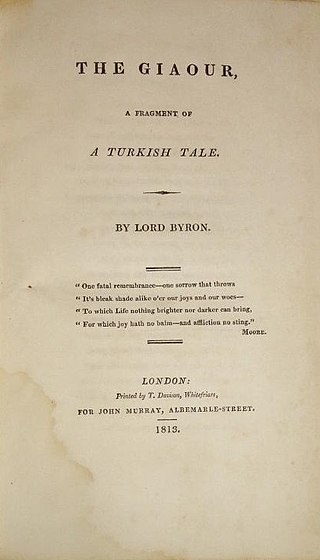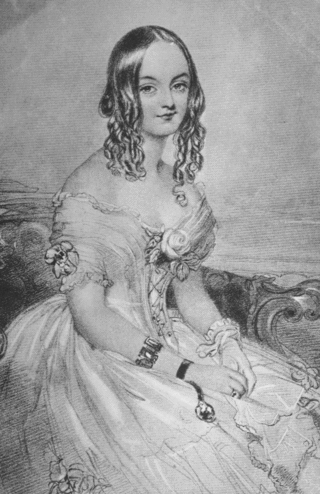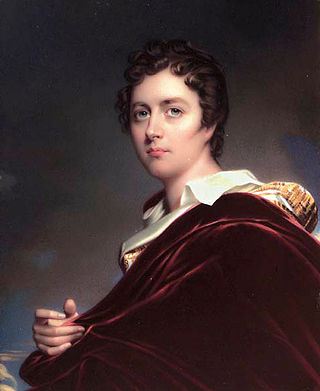
Darby and Joan is a proverbial phrase for a married couple content to share a quiet life of mutual devotion.

Dionysios Solomos was a Greek poet from Zakynthos, who is considered to be Greece's national poet. He is best known for writing the Hymn to Liberty, which was set to music by Nikolaos Mantzaros and became the Greek and Cypriot national anthem in 1865 and 1966 respectively. He was the central figure of the Heptanese School of poetry. He is considered the national poet of Greece, not only because he wrote the national anthem, but also because he contributed to the preservation of earlier poetic tradition and highlighted its usefulness to modern literature. Other notable poems include Ὁ Κρητικός, Ἐλεύθεροι Πολιορκημένοι. A characteristic of his work is that no poem except the Hymn to Liberty was completed, and almost nothing was published during his lifetime.

Augusta Maria Leigh was the only daughter of John "Mad Jack" Byron, the poet Lord Byron's father, by his first wife, Amelia, née Darcy.
This is a chronology of events in the life of George Gordon Byron, 6th Baron Byron. Each year links to its corresponding "year in poetry" article:

Katharine Tynan was an Irish writer, known mainly for her novels and poetry. After her marriage in 1893 to the Trinity College scholar, writer and barrister Henry Albert Hinkson (1865–1919) she usually wrote under the name Katharine Tynan Hinkson, or variations thereof. Tynan's younger sister Nora Tynan O'Mahony was also a poet and one of her three children, Pamela Hinkson (1900–1982), was also known as a writer. The Katharine Tynan Road in Belgard, Tallaght is named after her.

Childe Harold's Pilgrimage is a long narrative poem in four parts written by Lord Byron. The poem was published between 1812 and 1818. Dedicated to "Ianthe", it describes the travels and reflections of a young man disillusioned with a life of pleasure and revelry and looking for distraction in foreign lands. In a wider sense, it is an expression of the melancholy and disillusionment felt by a generation weary of the wars of the post-Revolutionary and Napoleonic eras. The title comes from the term childe, a medieval title for a young man who was a candidate for knighthood.

The Giaour is a poem by Lord Byron first published in 1813 by John Murray and printed by Thomas Davison. It was the first in the series of Byron's Oriental romances. The Giaour proved to be a great success when published, consolidating Byron's reputation critically and commercially.

In English literature, Don Juan, written from 1819 to 1824 by the English poet Lord Byron, is a satirical, epic poem which portrays the Spanish folk legend of Don Juan, not as a womaniser as the character is historically portrayed, but as a victim easily seduced by women. As genre literature, Don Juan is an epic poem, written in ottava rima and presented in sixteen cantos. Lord Byron derived the character of Don Juan from traditional Spanish folk legends, however the story was very much his own. Upon publication in 1819, cantos I and II were widely criticized as immoral because Byron had so freely ridiculed the social subjects and public figures of his time. At his death in 1824, Lord Byron had completed sixteen of seventeen cantos, whilst canto XVII remained unfinished.
Nicolo or Nicolas Giraud was a friend of English Romantic poet Lord Byron. The two met in 1809 while Byron was staying in Athens. Giraud, who at that time of their relationship was a fourteen-year-old majordomo and then student at the Capuchin monastery in Athens, reportedly taught Byron Italian, and was his travel companion in Greece. Byron paid for Giraud's education and left him £7,000 in his will. Years after they parted company, Byron changed his will to exclude Giraud. Other than his involvement with Byron, little is known of Giraud's life.

Mazeppa is a narrative poem written by the English Romantic poet Lord Byron in 1819. It is based on a popular legend about the early life of Ivan Mazepa (1639–1709), who later became Hetman of Ukraine. Byron's poem was immediately translated into French, where it inspired a series of works in various art forms. The cultural legacy of Mazeppa was revitalised with the independence of Ukraine in 1991.

Clara Allegra Byron was the illegitimate daughter of the poet George Gordon, Lord Byron, and Claire Clairmont.
"The River Merchant's Wife: A Letter" is a four stanza poem, written in free verse, and loosely translated by Ezra Pound from a poem by Chinese poet Li Bai. It first appeared in Pound's 1915 collection Cathay. It is the most widely anthologized poem of the collection. In addition to "The Jewell Stairs' Grievance" and "The Exile's Letter", also included in the collection, Zhaoming Qian has referred to "The River Merchant's Wife" as an "imagist and vorticist [masterpiece]".

Teresa, Contessa Guiccioli (1800–1873) was the married lover of Lord Byron while he was living in Ravenna and writing the first five cantos of Don Juan. She wrote the biographical account Lord Byron's Life in Italy.

George Gordon Byron, 6th Baron Byron was a British poet and peer. He is one of the major figures of the Romantic movement, and is regarded as being among the greatest of English poets. Among his best-known works are the lengthy narratives Don Juan and Childe Harold's Pilgrimage; much of his shorter lyrics in Hebrew Melodies also became popular.

The Bad Lord Byron is a 1949 British historical drama film about the life of Lord Byron. It was directed by David MacDonald and starred Dennis Price as Byron with Mai Zetterling, Linden Travers and Joan Greenwood.
"A slumber did my spirit seal" is a poem that was written by William Wordsworth in 1798 and first published in volume II of the 1800 edition of Lyrical Ballads. It is part of a series of poems written about a mysterious woman named Lucy, whom scholars have not been able to identify and are not sure whether she was real or fictional. Although the name Lucy is not directly mentioned in the poem, scholars nevertheless believe it to be part of the "Lucy poems" due to the poem's placement in Lyrical Ballads.
The Vision of Judgment (1822) is a satirical poem in ottava rima by Lord Byron, which depicts a dispute in Heaven over the fate of George III's soul. It was written in response to the Poet Laureate Robert Southey's A Vision of Judgement (1821), which had imagined the soul of king George triumphantly entering Heaven to receive his due. Byron was provoked by the High Tory point of view from which the poem was written, and he took personally Southey's preface which had attacked those "Men of diseased hearts and depraved imaginations" who had set up a "Satanic school" of poetry, "characterized by a Satanic spirit of pride and audacious impiety". He responded in the preface to his own Vision of Judgment with an attack on "The gross flattery, the dull impudence, the renegado intolerance, and impious cant, of the poem", and mischievously referred to Southey as "the author of Wat Tyler", an anti-royalist work from Southey's firebrand revolutionary youth. His parody of A Vision of Judgement was so lastingly successful that, as the critic Geoffrey Carnall wrote, "Southey's reputation has never recovered from Byron's ridicule."

"Poor Susan" is a lyric poem by William Wordsworth composed at Alfoxden in 1797. It was first published in the collection Lyrical Ballads in 1798. It is written in anapestic tetrameter.

Byron's Memoirs, written between 1818 and 1821 but never published and destroyed soon after his death, recounted at full-length his life, loves and opinions. He gave the manuscript to the poet Thomas Moore, who in turn sold it to John Murray with the intention that it should eventually be published. On Lord Byron's death in 1824, Moore, Murray, John Cam Hobhouse, and other friends who were concerned for his reputation gathered together and burned the original manuscript and the only known copy of it, in what has been called the greatest literary crime in history.
Constance Smith, Mrs Spencer Smith - wife of a British diplomat John Spencer Smith, known as Florence in several Byron's poems.














